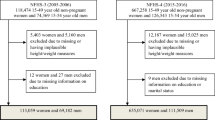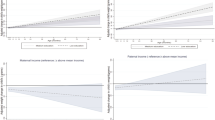Abstract
Objective:
To compare measures of growth and body fatness (body mass index (BMI) and % body fat) in children from two contrasting income backgrounds and to examine the contribution of height difference to these measures.
Design:
Cross-sectional study.
Setting:
Schools in inner East London (‘low income’) and West London, Hertfordshire and Cambridgeshire (‘high income’), UK.
Participants:
A total of 2298 children aged 5–14 years.
Main outcome measures:
Height, weight, BMI (weight per height2) and percentage body fat (%BF, by bioelectrical impedance analysis).
Results:
Children from the ‘lower income’ background were significantly shorter, heavier and fatter (%BF) with a higher BMI for their age compared with those from a ‘higher income’ background. Prevalence of overweight/obesity was greater in the ‘lower income’ group children, assessed on the basis of BMI, and this income group difference was magnified when based on %BF (overfat/obese). Irrespective of the assessment tool used, overweight/overfat/obese children as a group were significantly taller for their age compared with children categorized as normal weight/normal fat. Despite the overfat/obese children being taller for their age, an ‘income group’ difference in height remained within this category.
Conclusion:
These findings confirm the income group influence on obesity prevalence. They also illustrate that BMI underestimates the true number of children having excess body fat, particularly in ‘low income’ children. Exactly why BMI seems to function differently along income group divisions in unclear, but a shorter height-for-age of the ‘lower income’ group children could be one explanation. These findings raise important questions about the causes and consequences of obesity in children from ‘lower income’ backgrounds.
This is a preview of subscription content, access via your institution
Access options
Subscribe to this journal
Receive 12 print issues and online access
$259.00 per year
only $21.58 per issue
Buy this article
- Purchase on Springer Link
- Instant access to full article PDF
Prices may be subject to local taxes which are calculated during checkout

Similar content being viewed by others
References
Jebb SA, Rennie KL, Cole TJ . Prevalence of overweight and obesity among young people in Great Britain. Public Health Nutr 2004; 7: 461–465.
Moore DB, Howell PB, Treiber FA . Changes in overweight in youth over a period of 7 years: impact of ethnicity, gender and socioeconomic status. Ethn Dis 2002; 12: S1-83–S1-86.
Barlow SE, Dietz WH . Obesity evaluation and treatment: expert committee recommendations. Pediatrics 1998; 102: e29.
Pietrobelli A, Faith MS, Allison DB, Gallagher D, Chiumello G, Heymsfield SB . Body mass index as a measure of adiposity among children and adolescents: a validation study. J Pediatr 1998; 132: 204–210.
Reilly JJ, Dorosty AR, Emmett PM, The ALSPAC study team. Identification of the obese child: adequacy of the body mass index for clinical practice and epidemiology. Int Journal Obesity 2000; 24: 1623–1627.
Reilly JJ, Dorosty AR, Emmett PM . Prevalence of overweight and obesity in British children: cohort study. Brit Med J 1999; 319: 1039.
McCarthy HD . Body fat measurements in children as predictors for the metabolic syndrome: focus on waist circumference. Proc Nutr Soc 2006; 65: 385–392.
Mascie-Taylor CG, Lasker GW . Biosocial correlates of stature in a British national cohort. J Biosoc Sci 2005; 37: 245–251.
Cecil JE, Watt P, Murrie ISL, Wrieden W, Wallis DJ, Hetherington MM et al. Childhood obesity and socioeconomic status: a novel role for height growth limitation. Int J Obesity 2005; 29: 1199–1203.
McCarthy HD, Cole TJ, Fry T, Jebb SA, Prentice AM . Body fat reference curves for children. Int J Obesity 2006; 30: 598–602.
Tan YX, Nuñez C, Sun Y, Zhang K, Wang Z, Heymsfield SB . New electrode system for rapid whole-body and segmental bioimpedance assessment. Med Sci Sports Exerc 1997; 29: 1269–1273.
Freeman JV, Cole TJ, Chinn S, Jones PR, White EM, Preece MA . Cross sectional stature and weight reference curves for the UK, 1990. Arch Dis Child 1995; 73: 17–24.
Cole TJ, Freeman JV, Preece MA . Body Mass Index reference curves for the UK, 1990. Arch Dis Child 1995; 73: 25–29.
Cole TJ, Belizzi MC, Flegal KM, Dietz WH . Establishing a standard definition for overweight and obesity worldwide: international survey. Brit Med J 2000; 320: 1240–1243.
http://www.direct.gov.uk/en/Over5s/Benefits/BenefitsInRetirement/DG_10027190.
http://www.dfes.gov.uk/foischeme/subpage.cfm?action=collections.displaycollection&i_collectionID=15.
Lobstein TJ, James WPT, Cole TJ . Increasing levels of excess weight among children in England. Int J Obesity 2003; 27: 1136–1138.
Freedman DS, Khan LK, Serdula MK, Dietz WH, Srinivasan SR, Berenson GS . Inter-relationships among childhood BMI, childhood height, and adult obesity: the Bogalusa Heart Study. Int J Obes Relat Metab Disord 2004; 28: 10–16.
Moffat T, Galloway T, Latham J . Stature and adiposity among children in contrasting neighborhoods in the city of Hamilton. Amer J Hum Biol 2005; 17: 335–367.
Bueno MB, Marchioni DM, Fisberg RM . Changes in the nutritional status of children in public day care facilities in the municipality of Sao Paolo, Brazil. Rev Panam Salud Publica 2003; 14: 165–170.
Kuh DL, Power C, Rodgers B . Secular trends in social class and sex differences in adult height. Int J Epidemiol 1991; 20: 1001–1009.
Walker M, Shaper AG, Wannamethee G . Height and social class in middle-aged British men. J Epidemiol Community Health 1988; 42: 299–303.
Lukaski HC . Biological indexes considered in the derivation of the bioelectrical impedance analysis. Am J Clin Nutr 1996; 64: 397S–404S.
Acknowledgements
This study was supported by funding from the North Central London Research Consortium (NoCLoR) and the Learning Trust. Tanita UK Ltd provided funding for the development of the UK body fat reference curves for children.
Author information
Authors and Affiliations
Corresponding author
Ethics declarations
Competing interests
HDMc has previously received funding from Tanita UK Ltd., as indicated in the acknowledgements.
Rights and permissions
About this article
Cite this article
Samani-Radia, D., McCarthy, H. Comparison of children's body fatness between two contrasting income groups: contribution of height difference. Int J Obes 35, 128–133 (2011). https://doi.org/10.1038/ijo.2010.116
Received:
Revised:
Accepted:
Published:
Issue Date:
DOI: https://doi.org/10.1038/ijo.2010.116
Keywords
This article is cited by
-
Mediators of socioeconomic differences in overweight and obesity among youth in Ireland and the UK (2011–2021): a systematic review
BMC Public Health (2022)
-
Socioeconomic position and body composition in childhood in high- and middle-income countries: a systematic review and narrative synthesis
International Journal of Obesity (2021)
-
Socioeconomic inequalities in weight, height and body mass index from birth to 5 years
International Journal of Obesity (2018)
-
Adiposity among children in Norway by urbanity and maternal education: a nationally representative study
BMC Public Health (2013)
-
Beta-3-adrenergic receptor Trp64Arg polymorphism: does it modulate the relationship between exercise and percentage of body fat in young adult Japanese males?
Environmental Health and Preventive Medicine (2013)



